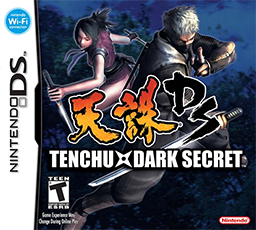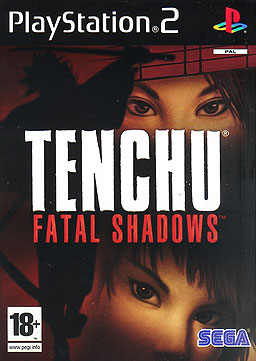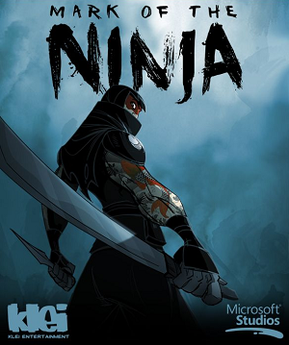A stealth game is a type of video game in which the player primarily uses stealth to avoid or overcome opponents. Games in the genre typically allow the player to remain undetected by hiding, sneaking, or using disguises. Some games allow the player to choose between a stealthy approach or directly attacking antagonists, but rewarding the player for greater use of stealth. The genre has employed espionage, counter-terrorism, and rogue themes, with protagonists that are special forces operatives, special agents, secret agents, thieves, ninjas, or assassins. Some games have also combined stealth elements with other genres, such as first-person shooters and also platformers.

Tenchu is an action-adventure stealth video game series owned by Japanese game publisher FromSoftware, where the player assumes the role of a ninja in 16th-century feudal Japan. The first game in the series titled Tenchu: Stealth Assassins was developed by Japanese developer Acquire and published in 1998. Later games have also been developed by K2 LLC and FromSoftware. The current rightsholder to the series is FromSoftware who bought the rights from Activision in 2004.

Urban Reign is a multiplayer beat 'em up game developed and published by Namco in 2005 exclusively for the PlayStation 2.

Tenchu: Stealth Assassins is a 1998 stealth video game developed by Acquire and published by Sony Music Entertainment Japan for the PlayStation. It is the first installment in the Tenchu series, with Activision releasing the game outside Japan. Following Rikimaru and Ayame of the Azuma ninja clan as they complete missions for their employer Lord Gohda in Sengoku-era Japan, the gameplay involves the player guiding their chosen character through missions, the aim being to remain undetected while either avoiding or quietly killing enemies.

Tenchu 2: Birth of the Stealth Assassins is a 2000 stealth video game developed by Acquire for the PlayStation. The second entry in the Tenchu series, it was published in the West by Activision and in Japan by Acquire. Tenchu 2 is a prequel to Tenchu: Stealth Assassins (1998), following the early lives of Azuma ninja Rikimaru and Ayame as they and their fellow Tatsumaru must confront a militant force called the Burning Dawn. Gameplay follows the chosen protagonist as they complete missions, the goal being to remain undetected and either avoid or silently kill enemies.

Tenchu: Dark Secret is an action-adventure stealth video game developed by Polygon Magic and published by FromSoftware in Japan and Nintendo worldwide for the Nintendo DS in 2006. It is also the first game in the Tenchu series to be released for the Nintendo system and not to have a Mature rating from the ESRB.

Red Ninja: End of Honor, known in Japan as Red Ninja: Kekka no Mai, is a 2005 video game for the PlayStation 2 and Xbox platforms, created in a collaboration between the game developer Tranji Studios and the film writer Shinsuke Sato. It was published by Vivendi Universal Games. The game's theme song "Foolish Dream" was performed by Yoko Ishida. The game was poorly received and was Tranji Studios' only published title.

Tenchu: Wrath of Heaven is an action-adventure stealth video game developed by K2 and published by Activision for the PlayStation 2 in 2003. FromSoftware published the game in Japan as Tenchu 3. It was later ported to the Xbox in 2004 under the title Tenchu: Return from Darkness and to the PlayStation Portable in 2009 by FromSoftware under the title Tenchu 3 Portable. A mobile version featuring 2D side-scrolling action gameplay was developed by TKO Software and released in 2005.

Tenchu: Fatal Shadows is an action-adventure stealth video game developed by K2 LLC and published by FromSoftware in Japan and Sega in North America and Europe for the PlayStation 2 in 2004. The PlayStation Portable version of the game, Tenchu Kurenai Portable, was released in Japan in 2010.

Tenchu: Time of the Assassins is an action-adventure stealth video game developed by K2 LLC and published by FromSoftware in Japan and Sega in Europe for the PlayStation Portable in 2005. This marks the first game in the series not to be released in North America.

Tenchu Z is an action-adventure stealth video game developed by K2 LLC and published by FromSoftware in Japan and Microsoft Game Studios worldwide for the Xbox 360 in 2006.

Vampire Rain is a survival horror stealth video game developed by Artoon. It was released for the Xbox 360 in Japan on January 25, 2007, and in North America on July 3, 2007. The game was later ported to the PlayStation 3 in 2008 under the title Vampire Rain: Altered Species. It received negative reviews for its difficulty, poor artificial intelligence, and controls.

Shinobido: Tales of the Ninja, known in Japan as Shinobidō: Homura, is a stealth game developed by Acquire and published by Spike for the PlayStation Portable. It is a spin-off to Shinobido: Way of the Ninja. A North American version was to be released as Shinobido Homura: Soul of the Ninja but was cancelled. The game was followed by a true sequel to the original game, Shinobido 2: Revenge of Zen.

Acquire Corp. is a Japanese video game developer and publisher, mainly known for their Tenchu and Way of the Samurai series.

Tenchu: Shadow Assassins is a stealth game developed by Acquire and published by FromSoftware in Japan and Ubisoft worldwide for the Wii in 2008 and the PlayStation Portable in 2009.

Shinobido 2: Revenge of Zen, known in Japan as Shinobidō 2: Sange, is a stealth video game developed by Acquire and published by Spike for the PlayStation Vita. Namco Bandai Games released the game outside Japan. It is a sequel to Shinobido: Way of the Ninja. A downloadable content pack, Mirror Spirits, was released on May 9, 2012. The game, along with its DLC, was removed from the PSN Store in 2016, most likely due to the license expiring from Bandai Namco in North America and the PAL region.
Senran Kagura is a multimedia franchise created by Kenichiro Takaki and developed primarily by Tamsoft and Marvelous. The series debuted in Japan in 2011 with the release of Senran Kagura: Shōjo-tachi no Shinei for the Nintendo 3DS and debuted abroad in 2013 with Senran Kagura Burst. The franchise has since expanded into numerous video games, manga adaptations, anime series, and merchandise.

Mark of the Ninja is a side-scrolling stealth platform game developed by Klei Entertainment and published by Microsoft Studios. It was announced on February 28, 2012, and later released for the Xbox 360 via Xbox Live Arcade on September 7, 2012. The game was released for Microsoft Windows on October 16, 2012, and for Linux and OS X on September 11, 2013. A remastered version was released on October 9, 2018, for Xbox One, PlayStation 4, Nintendo Switch, Microsoft Windows, macOS, and Linux by Klei Entertainment.

Nitroplus Blasterz: Heroines Infinite Duel is a fighting game developed by Examu's Team Arcana and published by Nitroplus. The game crosses over heroines from various visual novels and games released by Nitroplus, as well as those from manga and anime series that Nitroplus writers have been involved with. The game was released in arcades on April 30, 2015 and was released on PlayStation 3 and PlayStation 4 in collaboration with Marvelous Entertainment's Marvelous Inc. on December 10, 2015. Marvelous USA published the game in North America on February 2, 2016. It was later released on Windows on December 8, 2016. The game originates from the doujin game Nitro+ Royale: Heroines Duel, which is stated as its predecessor.

Senran Kagura: Peach Beach Splash is a 2017 third-person shooting video game in the Senran Kagura series, published by Marvelous and developed by Tamsoft. It was released for PlayStation 4, followed by a Microsoft Windows version in 2018. The game focuses on the Peach Beach Splash water gun tournament, to which female ninjas from various factions are invited, and where the winning team has any reward it wants. Players take the roles of the ninjas, and fight in various kinds of game modes, some of which are online multiplayer battles, and some of which are single-player.


















